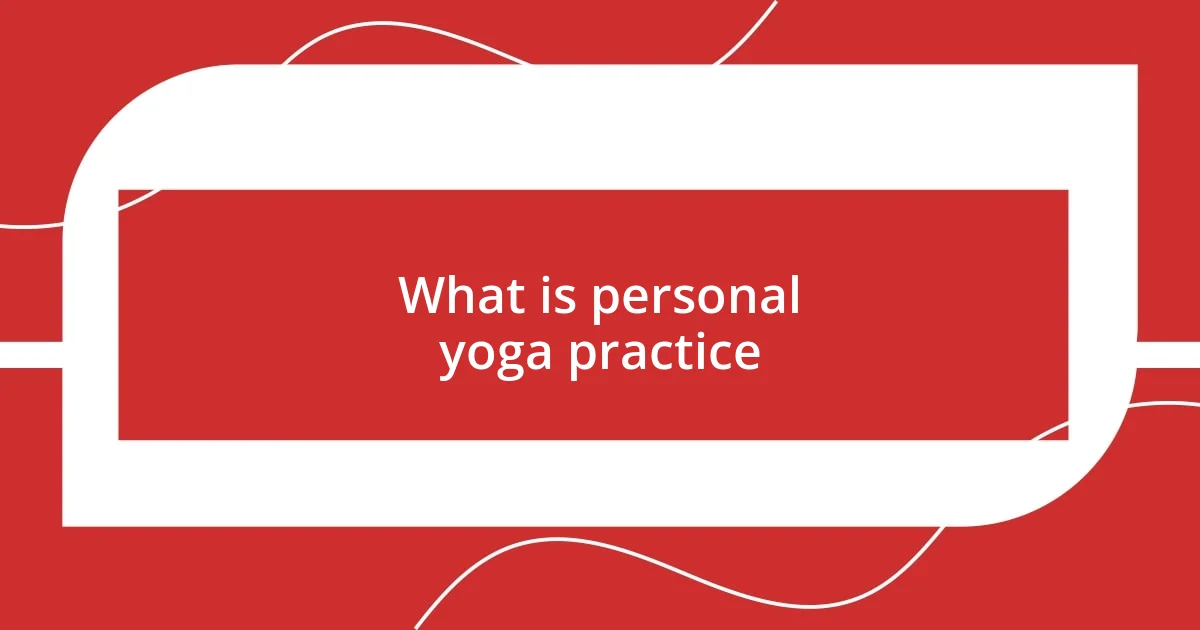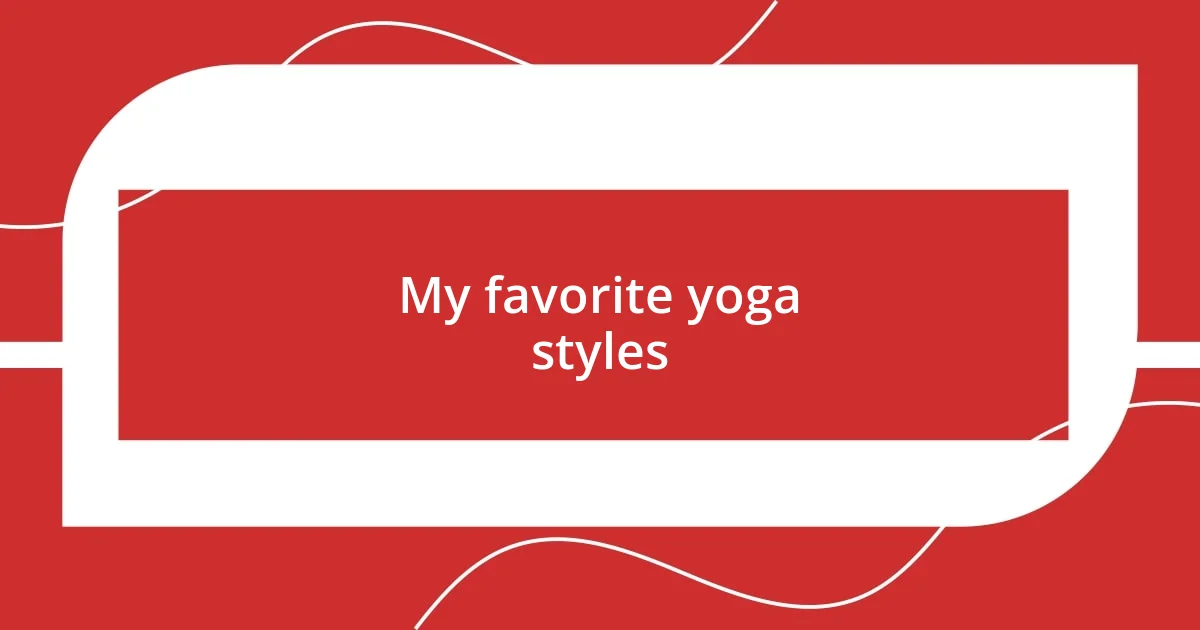Key takeaways:
- Personal yoga practice serves as a customized journey, allowing individuals to tailor routines to their emotional and physical needs, enhancing overall connection and fulfillment.
- Key elements for effective yoga include consistency, mindfulness, and variety, which together foster a deeper connection with the body and enhance the practice experience.
- Progress in yoga is more about emotional growth and self-connection than physical achievements; recognizing subtle shifts and personal milestones is crucial to understanding one’s journey.

What is personal yoga practice
Personal yoga practice is a deeply personal journey that caters to individual needs and preferences. For me, this means setting aside time each day to explore various poses and breathing techniques that resonate with my body and mind. Have you ever noticed how your energy levels shift when you dedicate that time just for yourself?
I remember the first time I practiced yoga alone, moving through a gentle flow while the sunlight streamed through the window. It felt like a dance with my thoughts, allowing me to release stress and connect with my inner self. In those moments, the world outside faded, and the only thing that mattered was my breath and the movement of my body. It’s incredible how such solitude can be both empowering and soothing.
Each practice can be tailored to how I feel on any given day, making it an intimate conversation between my body and spirit. Do you ever find that some days call for quiet reflection while others demand vigorous asanas? The flexibility of personal practice allows me to honor those impulses, turning my mat into both a sanctuary and a canvas for self-discovery. This unique aspect truly enriches my journey and can transform yours too.

Benefits of tailored yoga routines
Tailoring yoga routines can significantly enhance both the effectiveness and enjoyment of the practice. When I first experimented with adjusting my flows to meet my emotional and physical states, the difference was palpable. Some days, a high-energy sequence invigorates me, while on others, a restorative session melts away tension. This adaptability allows me to better connect with my body’s needs, creating a more fulfilling experience.
Here are a few benefits I’ve found from customized yoga practices:
- Increased Mind-Body Connection: Personalizing my routine fosters a deeper understanding of how my body responds to movement and breath.
- Emotional Balance: Tailored sessions help me navigate different emotional landscapes, offering me support when I feel anxious or overwhelmed.
- Progress Tracking: Having a flexible routine allows me to notice improvements in strength and flexibility tailored to my individual goals.
- Enhanced Motivation: I often feel more motivated to practice because each session feels relevant and aligned with my current state.
I’ve learned that this kind of personal investment in my yoga journey brings a sense of empowerment. The more I customize my practice, the more I realize yoga isn’t just about poses; it’s about nurturing my whole self.

Key elements of effective yoga
Effective yoga practice is founded on several key elements that harmonize the physical, mental, and emotional dimensions. For me, consistency stands out as an essential component. I’ve noticed that establishing a regular routine helps cultivate a sacred space for my practice. On days when I show up on my mat, even briefly, I feel a deeper connection to my breath and movements, as if my body remembers the flow we share. Have you felt that reassuring comfort when you step onto your yoga mat, knowing exactly what to expect?
Another vital element is mindfulness. I often remind myself to stay present during each pose, allowing the sensations and feelings to wash over me. I vividly recall a moment in a challenging balance pose, when I felt my focus wavering. Instead of succumbing to frustration, I took a deep breath and returned my awareness to the present. That shift not only saved me from losing my balance but also transformed my practice into a meditation—an opportunity to embrace imperfection and use it as a teacher.
Lastly, incorporating a variety of practices—such as breathwork and meditation—into my sessions keeps them fresh and engaging. I remember trying out a new pranayama technique one morning. While initially unfamiliar, it unraveled a wave of tranquility that enhanced my overall experience. Exploring different facets of yoga allows me to discover what resonates most and deepens my appreciation for the practice. Isn’t it fascinating how each element can intertwine, creating a rich tapestry of experiences on the mat?
| Key Element | Personal Insight |
|---|---|
| Consistency | Regular practice reinforces a joyful connection with my body and breath |
| Mindfulness | Staying present, especially in challenging poses, transforms my experiences into moments of meditation |
| Variety | Exploring breathwork and meditation keeps my practice dynamic and deepens my appreciation |

My favorite yoga styles
My favorite yoga styles reflect my evolving relationship with movement and mindfulness. For instance, I often gravitate toward Vinyasa flow when I need to energize my body. I vividly remember one morning, feeling sluggish and uninspired; rolling out my mat for a vigorous Vinyasa session transformed my mood almost instantly. The rhythm of breath matching movement made me feel alive, igniting a playful spirit that carried throughout my day.
In contrast, restorative yoga has won my heart during particularly stressful times. There’s something soothing about allowing my body to fully relax into poses, supported by props. I recall a particularly tough week when I was juggling several life demands. Slowing down and sinking into supported child’s pose provided me with a safe space to process my feelings. That gentle embrace from the earth felt like a hug, nurturing me back to a place of calm.
I can’t overlook the joy I find in practicing Yin Yoga, either. It’s a different kind of challenge that invites introspection and stillness. I remember the first time I held a pose like Butterfly for several minutes. It was uncomfortable at first but as I settled into it, I began to embrace the sensations rather than resist them. Isn’t it intriguing how, in those quiet moments, we can discover so much about ourselves? Each style offers me a unique lens through which I understand my body and mind, enriching my overall yoga journey.

Essential yoga props for success
When it comes to essential yoga props, I’ve found that they can truly elevate my practice. A good quality yoga mat is my foundation; it provides grip and comfort. Just the other day, I unrolled my mat before an intense flow, and I felt an immediate sense of security, as if it welcomed me back to my practice. Have you ever noticed how the right mat can transform the way you engage with each pose?
Blocks are another prop I cherish. They’ve been invaluable in helping me deepen stretches or maintain alignment when I can’t quite reach. I’ll never forget my first experience with a block during a forward fold; it was an eye-opener! Rather than straining and contorting, I was able to ground myself and feel the pose without the discomfort. Isn’t it fascinating how something so simple can shift our perspective and accessibility in yoga?
Lastly, bolsters have become my best friends during restorative sessions. I often use one to support my back in supported bridge pose, allowing my body to relax fully. One memorable evening, after a long day, I nestled into a bolster with a blanket and just let go. That simple setup transformed my practice into a healing experience, reminding me how essential it is to honor our need for rest and rejuvenation. Don’t you find that sometimes, it’s the props that guide us to deeper healing moments?

Understanding progress in yoga practice
Understanding progress in yoga practice can be both exciting and perplexing. I’ve found that it’s not always about achieving that perfect pose or mastering a challenging sequence. For me, progress often feels like the subtle shifts in how I relate to my body and breath on the mat. During a recent session, when my mind started to quiet down during a particularly tough balance pose, I realized I had come a long way from where I used to be—I was truly present in the moment.
Tracking progress in yoga can also mean recognizing the milestones along the way. I remember when I first attempted to hold downward facing dog for an extended period. It seemed daunting at the time, and I was tempted to come out of the pose early. But as the weeks went by, that same pose began to feel more accessible. It was less about perfection and more about the growing connection to my strength. Isn’t it remarkable how we can build resilience with patience and practice?
Sometimes, I notice that progress isn’t solely about physical achievements; it’s also about emotional transformation. Recently, after a challenging week, I stepped onto my mat feeling stressed and overwhelmed. By the end of my practice, I shed layers of tension that I didn’t even know I was carrying. I felt a profound sense of release wash over me, making me realize that every session cultivates a deeper understanding of myself. Do you ever find that yoga helps you unveil layers of your own emotional landscape? It’s those moments that truly illuminate the journey of progress in my practice.












